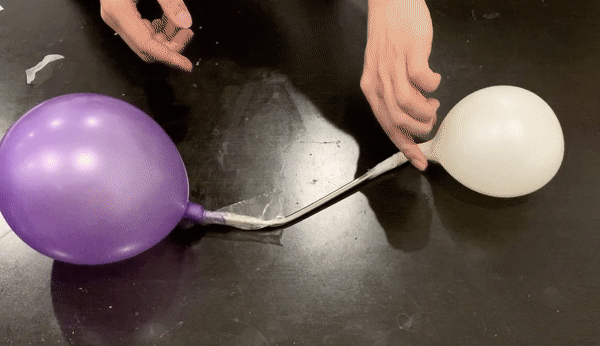A sometimes-counterintuitive experiment, demonstrating the equalising of air pressure in two connected balloons
What you need: balloons, straw, sticky tape, peg or something to block off the straw
What you do:
- Blow up one balloon so it is quite large
- Place the straw in the end of the balloon and secure it with tape. Block off the end of the straw to stop air escaping. You could use a peg or something similar for this
- Blow up the other balloon so it is quite small
- Place the other end of the straw in the small balloon and secure it with sticky tape
- What do you think will happen when you remove the peg? Try it! Remove the peg so air can move through the straw and see what happens
How this works:
- pressure in the balloon = pressure from the surface tension in rubber skin + atmosphere pressure
- the pressure in the big balloon changes to balance the pressure in the small balloon
- the pressure contribution from the surface tension is inversely proportional to the radius of the balloon.
So the smaller balloon has larger pressure from surface tension than the bigger balloon. As the result, the air in the smaller balloon will flow into the bigger one and it will get smaller.
However, there are exemptions: the behaviour of the rubber skin is not trivial. If I squash the white one to make it smaller and make purple one as big as the white balloon was, the white one will become bigger and purple become smaller because of the hysteresis of the stress-strain curve of balloons.
In summary, the rubber skin of balloons has a significant influence on how the size of balloons will change. The two balloons eventually want to achieve an equilibrium state where the pressure difference between them is zero.
—This homescience activity written by PhD candidate Qile Li (Monash)

